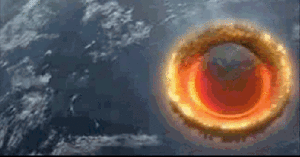Planetary securityImpact: Earth! Web site calculates asteroid impact effects on Earth
Purdue University researchers unveils the Impact Earth! Web site; the site allows visitors to use a calculator to calculate the potential damage a comet or asteroid would cause if it hit the Earth; visitors enter parameters such as the diameter of the impact object, its density, velocity, angle of entry, and where it will hit the Earth, and the site estimates the consequences of its impact, including the atmospheric blast wave, ground shaking, size of tsunami generated, fireball expansion, distribution of debris, and size of the crater produced

Artist rendering of an asteroid impact on earth // Source: mchsi.com
Purdue University last week unveiled Impact: Earth! a new Web site that allows anyone to calculate the potential damage a comet or asteroid would cause if it hit the Earth.
The interactive Web site is scientifically accurate enough to be used by homeland security and NASA, but user-friendly and visual enough for elementary school students, said Jay Melosh, the distinguished professor of earth and atmospheric sciences and physics at Purdue who led the creation of the impact effects calculator.
”The site is intended for a broad global audience because an impact is an inevitable aspect of life on this planet and literally everyone on Earth should be interested,” said Melosh, who is an expert in impact cratering. ”There have been big impacts in the past, and we expect big impacts in the future. This site gives the lowdown on what happens when such an impact occurs.”
More than 100 tons of material from asteroids and comets hits the Earth every day, he said. Even fragments as large as a sedan hurtle toward the planet a few times each year, but these burn up as they enter the atmosphere.
”Fairly large events happen about once a century,” Melosh said. ”The biggest threat in our near future is the asteroid Apophis, which has a small chance of striking the Earth in 2036. It is about one-third of a mile in diameter, and the calculator will tell what will happen if it should fall in your backyard.”
Users first enter a few parameters such as the diameter of the impact object, its density, velocity, angle of entry, and where it will hit the Earth. The site then estimates the consequences of its impact, including the atmospheric blast wave, ground shaking, size of tsunami generated, fireball expansion, distribution of debris, and size of the crater produced.
Massive asteroids, like the 9-mile-wide Chicxulub that killed the dinosaurs sixty-five million years ago, are very rare, but smaller and more common asteroids have left craters that remain today. For instance, Arizona’s famous Barringer Crater — nearly a mile wide — is evidence of an impact 50,000 years ago from an asteroid estimated to be 164 feet in diameter and composed of nickel and iron.
According to the impact calculator, if an asteroid of similar composition but twice as large hit about twenty miles outside of Chicago, the impact energy would be equivalent to about ninety-seven megatons of TNT. The resulting crater would
